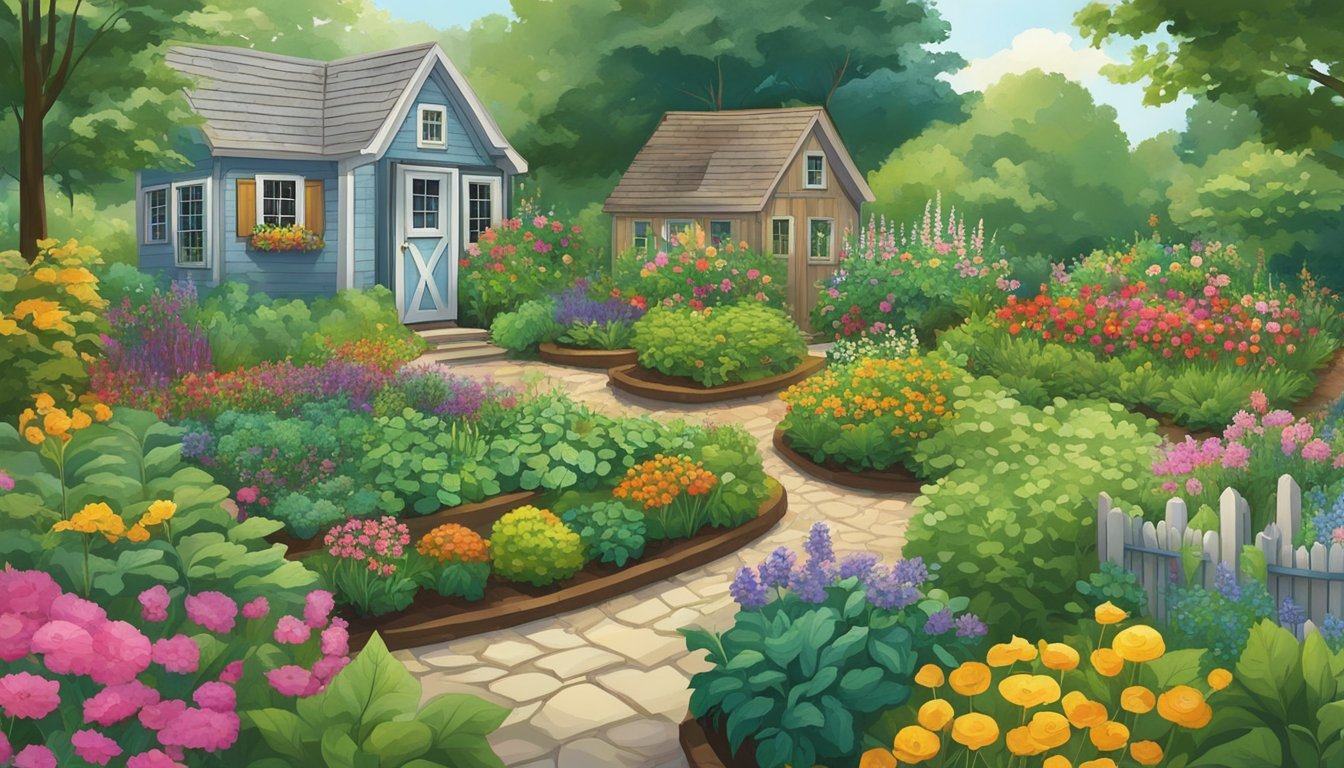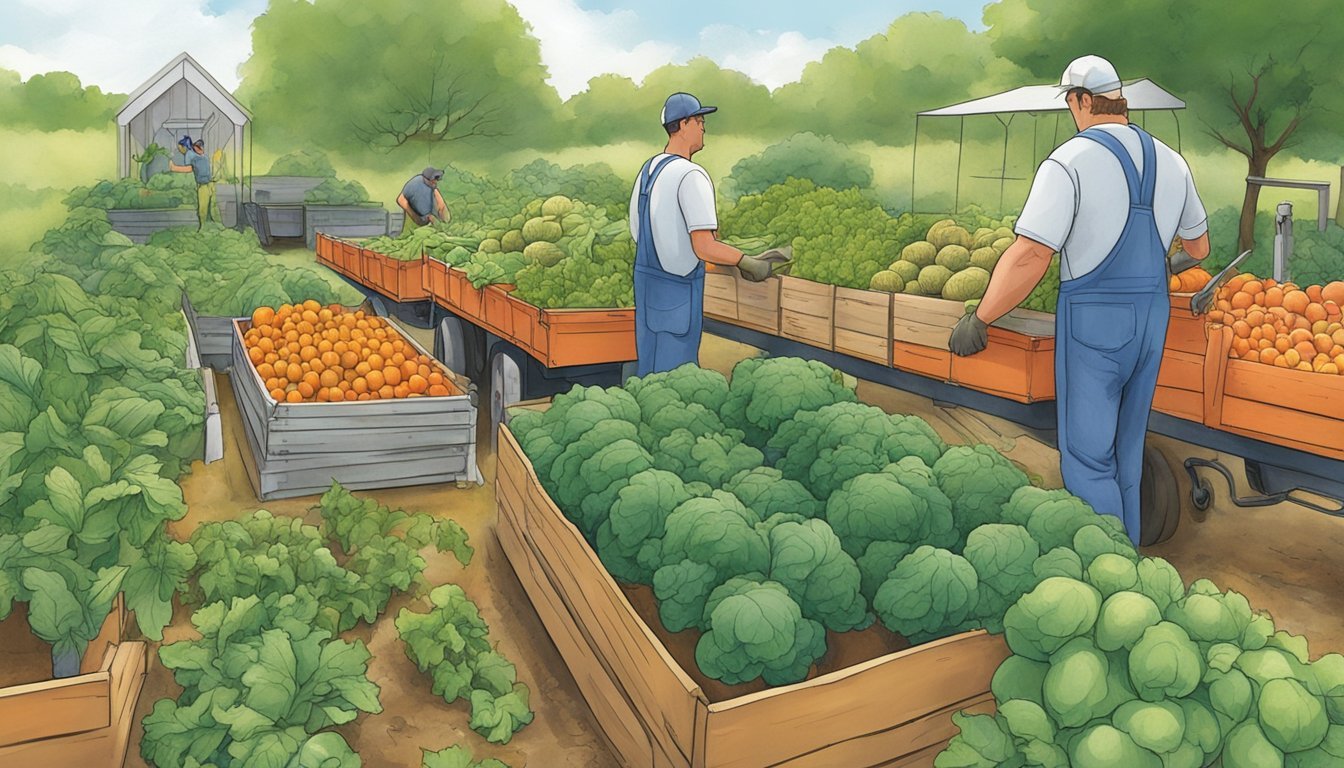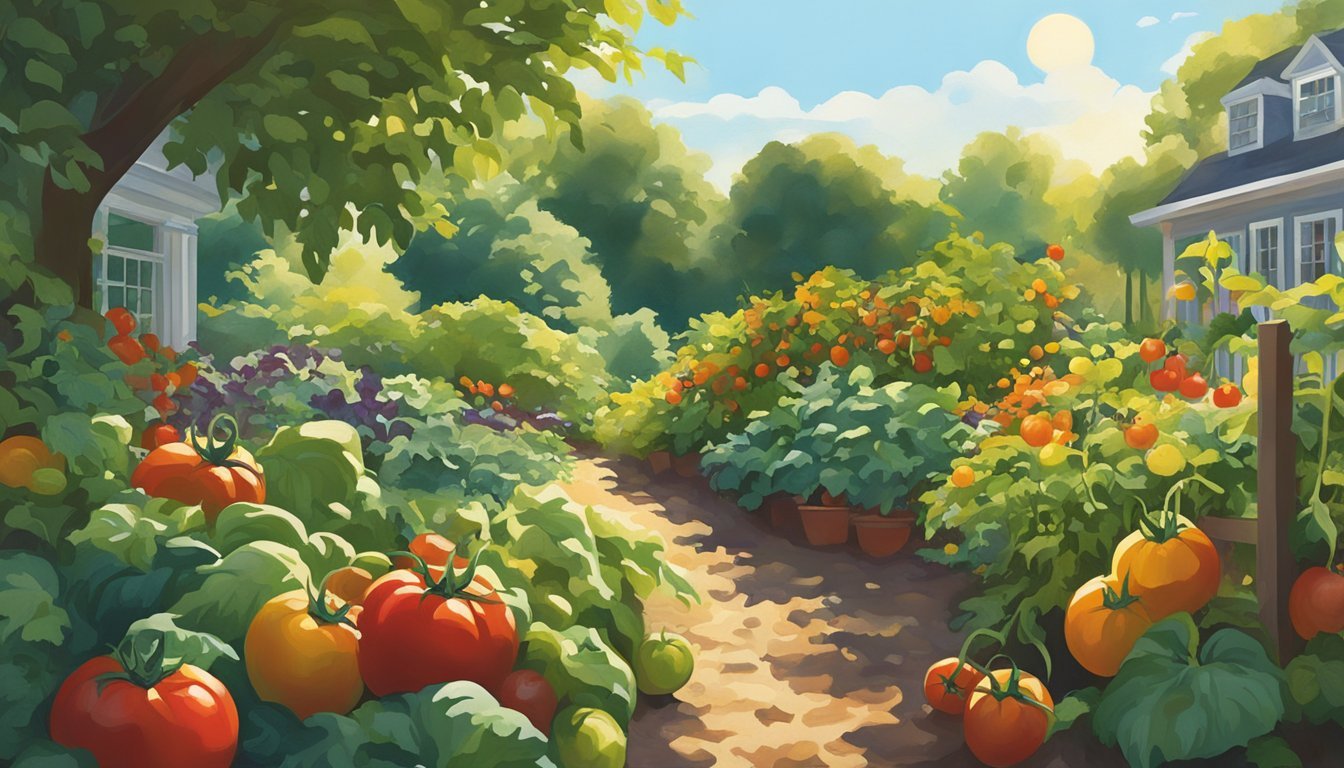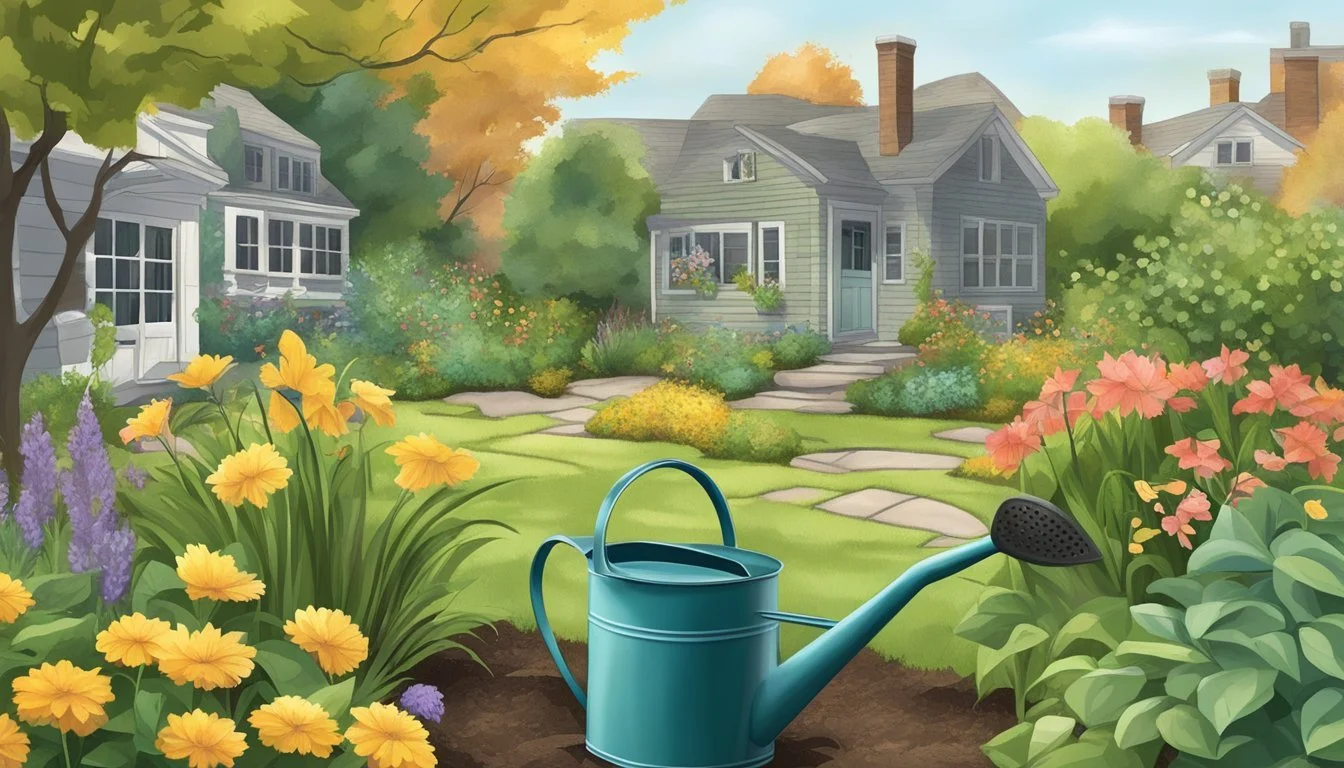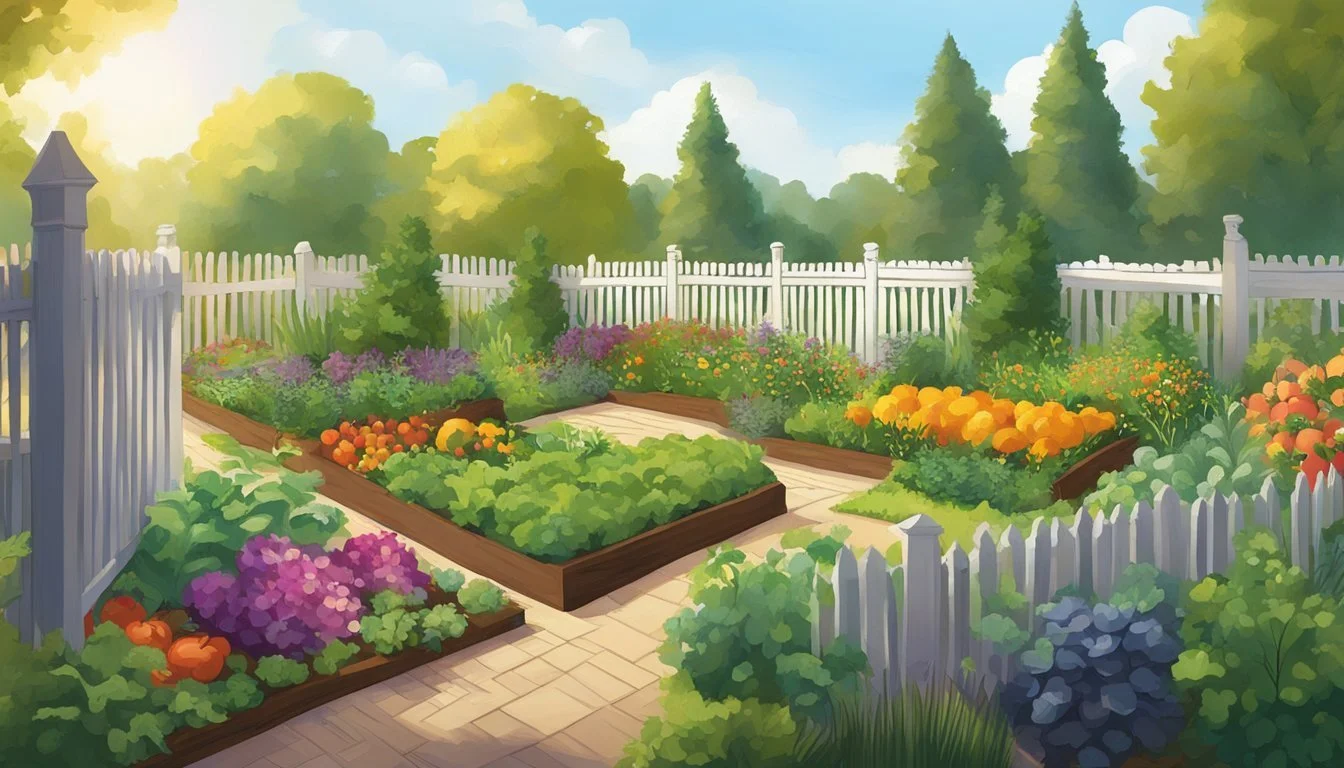Vegetable Gardening in New Jersey
A Guide to Thriving Gardens
This Article is Part of Our Guide on Vegetable Gardening by State
Vegetable gardening in New Jersey offers a fulfilling experience for both novice and seasoned gardeners. The Garden State's moderate climate and fertile soils provide a conducive environment for a variety of vegetables to flourish. Planting calendars are critical tools for gardeners, guiding them on the optimal planting times for each vegetable. Due to the state's diverse weather patterns, the calendars are tailored to New Jersey's specific conditions, ensuring that vegetables like lettuce can thrive even in cooler temperatures, making the most of the state's cold spring and fall months.
Understanding the specific gardening zones within New Jersey, such as zones 6 and 7, is vital for success in vegetable gardening. These zones significantly influence the selection of plants as well as the timing for planting seeds (how long do seeds last?) or transplants. For instance, leafy greens such as lettuce and spinach require fewer direct sunlight hours, making them suitable for areas with partial shade. In contrast, fruiting vegetables like tomatoes demand longer exposure to sunlight and more warmth. Gardeners in New Jersey take these factors into account to optimize their yield.
New Jersey gardeners employ strategies such as starting seeds indoors during late winter or early spring to prepare for the growing season. This approach allows for an extended growing period, especially for warmth-loving vegetables that would otherwise have a shorter window for cultivation outdoors. The timing for transplanting seedlings into the garden is carefully calculated based on local frost dates, ensuring that plants are established at the right time to maximize growth and productivity.
Planning Your Vegetable Garden
Planning a successful vegetable garden in New Jersey requires knowledge of the region’s planting zones, an understanding of the local climate, and the selection of appropriate crops for the area. Here is how gardeners can plan effectively.
Understanding Your Hardiness Zone
New Jersey spans USDA plant hardiness zones 6-7, indicating the state experiences a range of minimum temperatures from -10 to 0°F (-23 to -18°C). Gardeners should refer to these zones to guide their selection of vegetables, ensuring compatibility with local climate conditions.
Selecting a Suitable Location
For optimal growth, most vegetables require a location with full sun (at least 6-8 hours of direct sunlight daily). Leafy vegetables like lettuce may tolerate slightly less sun (around 4 hours), whereas fruiting vegetables like tomatoes demand the most.
Choosing Vegetables to Grow
Leafy Greens: such as lettuce and spinach, are cold-hardy and suitable for cooler seasons.
Root Vegetables: like carrots and beets, need moderate sunlight and consistent moisture.
Fruiting Vegetables: tomatoes, cucumbers, and peppers, require more sunlight and warmth.
Developing a Garden Layout
Plan the garden so that taller plants don't shade shorter ones. Also, consider the spread of mature plants to avoid overcrowding. Rows or beds should be spaced to allow for easy maintenance.
Timing and Planting Schedules
Spring: Start cold-hardy vegetables, like peas and leafy greens, after the last frost date.
Summer: Plant warm-season crops, such as tomatoes and peppers, well after any danger of frost has passed.
A garden calendar reflecting New Jersey's seasonal changes assists in deciding when to plant each variety for maximum yield.
Soil Preparation and Management
Proper soil preparation is crucial for successful vegetable gardening in New Jersey. It ensures that the soil provides the necessary nutrients and environment for vegetable growth.
Analyzing Soil Conditions
The initial step in soil preparation is to determine the soil type and pH level. New Jersey soil varies from sandy in the coastal regions to clay-heavy in the northern parts. A soil test can reveal pH and nutrient levels, which guide gardeners on amendment needs. Ideal soil pH for most vegetables is between 6.0 and 7.0, and soil tests should be conducted every few years to monitor conditions.
Amending and Fertilizing Soil
Once soil conditions are known, amending the soil becomes essential for nutrient balance and structure. Organic material, such as compost or aged manure, can be incorporated to improve fertility. These materials not only enrich the soil with nutrients but also enhance its physical structure. A general recommendation for fertilizers is to use them in moderation and according to specific plant needs, as over-fertilization can have adverse effects.
Commercial fertilizers are often labeled with N-P-K ratios (nitrogen, phosphorus, potassium). For instance:
A 10-10-10 ratio is balanced and used generally.
A higher nitrogen content (e.g., 16-6-4) is suitable for leafy vegetables.
Improving Soil Drainage
Soil with poor drainage needs attention, as waterlogged soil can lead to root diseases and poor plant health. Sandy soil offers good drainage but may require more organic matter to hold moisture and nutrients. Conversely, clay soil retains water and nutrients well but often requires aeration. Amending with organic matter can help balance drainage and water retention. Raised beds are also an effective solution for improving drainage while providing a designated growing area.
Planting Your Garden
In New Jersey, successful vegetable gardening begins with understanding the right timing and methods for planting. Gardeners can start seeds indoors, transplant seedlings, or directly sow seeds into their gardens following the seasonal guidelines for optimal growth.
Starting Seeds Indoors
Gardeners in New Jersey typically start seeds indoors to get a jumpstart on the growing season. The process involves planting seeds in small containers or trays with potting soil and providing them with adequate warmth and light. Here is a basic timeline for starting seeds indoors:
6-8 weeks before the last frost date: Start seeds for cool-season crops like lettuce and kale.
4-6 weeks before the last frost date: Begin seeds for warm-season vegetables, such as tomatoes and peppers.
Transplanting Seedlings
Young plants or seedlings grown indoors must be carefully acclimated to outdoor conditions through a process called "hardening off." Transplanting seedlings into the garden should adhere to the following schedule:
After the danger of frost has passed: Transplant hardy vegetables like kale and lettuce.
Wait 1-2 weeks after the last frost date: Move warm-loving vegetables, such as tomatoes, to the garden.
Direct Sowing Seeds
Alternatively, seeds can be directly sown into the soil when conditions are right. This method is suitable for crops that do not transplant well or prefer to grow in place. Timing for direct sowing is crucial:
Early spring, as soon as the ground can be worked: Sow seeds of cool-season crops such as peas and spinach.
After the last frost date: Plant seeds of warm-season crops like beans and squash.
When sowing seeds directly, ensure that the soil is loose, well-drained, and free of large clumps. Plant seeds at the depth recommended on the seed packet, and keep the soil consistently moist until germination.
Maintaining Your Garden
Maintaining a garden in New Jersey requires attention to watering, pest and disease control, and soil management. Proper maintenance can lead to a bountiful and healthy harvest.
Watering Strategies
Gardeners must strike a balance between too much and too little water. The use of soaker hoses or a drip irrigation system can provide consistent moisture and reduce water waste. Rain barrels can also be employed to collect and conserve rainwater for garden use.
Managing Pests and Diseases
Monitoring plants regularly for signs of pests and diseases is crucial. Early detection can limit damage. Gardeners should consider environmentally friendly options like neem oil or insecticidal soaps to manage infestations without harming beneficial insects.
Weeding and Mulching
Weeds compete with vegetables for nutrients and water, so regular weeding is essential. Mulching with straw or shredded leaves can suppress weeds, help retain soil moisture, and add organic matter to the soil as it decomposes.
Utilizing Integrated Pest Management (IPM)
IPM promotes the use of a variety of methods to manage pests and disease, including cultural tactics, physical barriers like fencing, and biological controls. This approach aims to minimize pesticide usage and promote ecological balance in the garden.
Specific Vegetable Guides
This section provides detailed instructions on cultivating various types of vegetables in New Jersey. Each subsection focuses on different vegetable groups suited to the local climate and soil conditions.
Growing Leafy Greens
Leafy greens such as lettuce and spinach grow well in New Jersey's cool spring and fall temperatures. They prefer areas with 4 to 5 hours of sunlight daily.
Lettuce: Plant varieties like Butterhead and Loose Leaf. These are cold hardy and can even sustain frost conditions.
Spinach: Sow spinach seeds as early as the soil can be worked. It's a fast grower and can be harvested multiple times per season.
Kale: This hardy green can grow in full sun to partial shade and benefits from the state's cooler temperatures.
Cultivating Nightshades
Nightshades such as tomatoes, peppers, and eggplants require at least 8 hours of sunlight to thrive.
Tomatoes: Choose varieties like Beefsteak or Cherry for best results. Make sure they are supported with cages or stakes as they grow.
Peppers: Both sweet and hot pepper varieties do well in New Jersey. They need well-draining soil and plenty of sun.
Harvesting Root Vegetables
Root vegetables like carrots, beets, and radishes require 5 to 6 hours of sunlight and well-prepared soil that allows roots to penetrate deeply.
Carrots: Loose, sandy loam soil is ideal for growing straight, unblemished carrots.
Beets: These can be planted in both spring and fall for a double harvest.
Radishes: Fast-growing radishes are an excellent choice for beginners and can be planted several times throughout the growing season.
Tending to Cucurbits
Cucurbits such as cucumbers, zucchini, and other squashes need at least 8 hours of sunlight and space to spread.
Cucumbers: Train them onto a trellis or fence to save space and promote healthier growth.
Zucchini: Allow for ample space between plants to reduce humidity and prevent fungal infections, especially during New Jersey's humid summers.
Supporting Legumes
Legumes like beans, peas, and okra are valuable additions to the garden for their nitrogen-fixing abilities and ease of growth.
Beans: Both pole and bush beans can be grown, with pole beans needing vertical support.
Snow Peas: Plant these in early spring as they can tolerate and even thrive in cooler weather.
Okra: Although it's heat loving, okra can be successful in New Jersey with a well-chosen sunny spot and ample space to grow.
Extending the Growing Season
Gardeners in New Jersey can extend their vegetable gardening season beyond the typical frost dates by adopting certain practices. These methods capitalize on microclimates, protect plants from cold snaps, and utilize cold-tolerant species to keep the garden productive into the cooler months.
Implementing Cold Frames
Cold frames provide a microclimate with controlled exposure to sun and wind, effectively creating a miniature greenhouse. They consist of a transparent top that allows light in and a solid, insulated frame that retains heat. Gardeners can build cold frames using various materials such as wood or bricks.
Benefits:
Protects plants from frost
Warms soil for earlier planting
How to Use:
Place cold frames in a sunny, protected location.
Use during early spring and late fall.
Using Row Covers
Row covers offer a lightweight and more flexible solution for protecting plants from frost. A row cover can be draped directly over plants or supported by wire hoops. Made from materials like polyethylene or garden fabric, they trap heat while still allowing light and water to reach the plants.
Benefits:
Creates a barrier against cold
Can be installed or removed easily
Installation Tips:
Secure the edges with rocks or soil.
Use during unexpected frost or extended cold periods.
Choosing Cold Hardy Varieties
Selecting vegetable varieties that can tolerate cold temperatures is essential for extending the season. Cold hardy vegetables can survive even when temperatures drop below freezing, making them ideal for New Jersey’s variable climate.
Examples of Cold Hardy Vegetables:
Spinach
Kale
Brussels sprouts
Planting Recommendations:
Start cold hardy seeds earlier than other varieties.
Consult the New Jersey planting calendar for specific dates.
Harvesting and Storing Produce
Proper harvesting and storing techniques are crucial for gardeners in New Jersey to ensure the longevity and quality of their produce. Following best practices helps to maximize the enjoyment of the fruits and vegetables grown throughout the season.
Best Practices for Harvesting
One should always harvest vegetables at their peak of maturity. For instance, tomatoes are best picked when they are firm and fully colored. Leafy greens like lettuce, on the other hand, should be harvested in the morning when they are most crisp. It’s imperative to use clean, sharp tools to avoid damaging the plants or the vegetables.
Cleaning and Storing Vegetables
After harvesting, vegetables should be cleaned gently but thoroughly to remove any soil or garden residue. They must be dried to prevent mold and then stored in a way that accommodates each vegetable's specific needs. Root vegetables like carrots and beets can be stored in cool, humid conditions, often in bins of damp sand to keep them fresh. Tomatoes and peppers prefer room temperature until they fully ripen.
Table: Ideal Storage Conditions for Common NJ Vegetables
Vegetable Temperature Humidity Storage Life Tomatoes 55-70°F Moderate 2-4 weeks Carrots 32-40°F High 4-6 months Lettuce 32-40°F High 1-2 weeks Peppers 55-70°F Moderate 2-3 weeks
Tracking Harvest Times
A gardener should note the timing of harvests to help anticipate future needs and adjust planting schedules. Vegetables like beets and romaine lettuce, which thrive in the cooler temperatures of spring and fall, have different harvesting windows compared to summer crops like tomatoes. Keeping a gardening journal can be highly beneficial for tracking this information.
Enhancing Your Garden
Optimizing space and increasing yields are crucial for a successful vegetable garden in New Jersey. Gardeners can benefit from innovative techniques that not only enhance productivity but also add aesthetic value to the garden space.
Vertical Gardening Techniques
Vertical gardening is an efficient method to maximize garden space and can lead to higher vegetable yields. By growing upwards, one utilizes vertical space that would otherwise remain unused. For instance, trellises, stakes, and garden netting can support climbing plants like cucumbers and pole beans, effectively increasing the plantable surface area. Crucial considerations for vertical gardening include:
Structural support: Ensuring stable and sturdy structures to sustain plant weight.
Sun exposure: Positioning the vertical elements to not shade other sun-loving plants.
Companion Planting
Companion planting is a strategic approach to garden planting. Certain plants, when grown together, can deter pests, enhance soil nutrients, and improve pollination, resulting in a more robust garden. For example, marigolds can be planted alongside tomatoes to repel nematodes. Key benefits of companion planting involve:
Pest management: Natural pest deterrents reduce the need for chemical pesticides.
Soil health: Some plants, like beans, fix nitrogen in the soil, benefiting neighboring crops.
Decorative and Functional Planting
Incorporating ornamental elements into a vegetable garden can serve both decorative and functional purposes. Ornamental plants like lavender can attract pollinators essential for vegetable plant reproduction, contributing to increased yields. The strategic placement of such plants can create an attractive and productive garden space. Practical tips include:
Aesthetic appeal: Choosing ornamental plants that complement the visual design of the vegetable garden.
Pollinator-friendly: Selecting flowering plants that attract bees, butterflies, and other pollinators.
By applying these techniques, one can significantly enhance the functionality and appearance of their New Jersey vegetable garden.
Gardening in Urban Areas
In New Jersey's urban areas, residents are turning toward innovative gardening approaches due to space constraints. They make the most of limited space, from balconies and rooftops to shared community plots, growing fresh produce that contributes to their health and environment.
Small-Space Gardening
City dwellers in New Jersey cities, including Newark, Jersey City, and East Orange, are adopting small-space gardening techniques. They utilize every inch of their limited terrain, often in backyards or even along narrow alleyways. Innovative methods such as vertical gardening and container planting enable the cultivation of a variety of vegetables like lettuce, which is cold hardy and low-maintenance, perfect for small plots that may receive less sunlight.
Vertical gardening: Utilizing upward space with trellises, shelves, or hanging planters.
Container gardening: Growing in movable containers that can fit into small nooks.
Trenton and Passaic residents might select dwarf varieties of plants that require less room to thrive, and employ companion planting to maximize yields.
Balcony and Rooftop Gardening
Balconies and rooftops provide valuable space for residents of Clifton and Jersey City to grow their own food. These areas offer not just space but also ample sunlight, which is ideal for a range of vegetables and even small fruit trees. Apple trees, known for being cold-hardy, are suitable for rooftop gardens since they can tolerate cooler spring and fall temperatures. Here, it's critical to ensure containers are secure and plants are well-suited for potentially windy conditions.
Community Gardening Projects
Community gardens are flourishing across New Jersey urban areas, including locations like Newark and Camden. These gardens promote healthy eating by providing access to fresh vegetables and fruits. For instance, Camden gardeners have successfully harvested substantial amounts of produce, indicating the practical impact of community gardening initiatives. These projects typically involve:
Shared plots: Residents work collectively on larger gardening areas.
Educational programs: Offering guidance on urban gardening practices to participants.
Urban agriculture in New Jersey's cities continues to grow, enabling residents to enjoy the benefits of gardening despite space limitations.
Wildlife and Your Garden
In New Jersey, wildlife can play a significant role in the success of a vegetable garden. Gardeners may face challenges from deer and small animals, but they also have the opportunity to attract pollinators and beneficial birds and insects that can enhance plant health and productivity.
Dealing with Deer and Small Animals
New Jersey gardeners are familiar with the sight of deer amid their vegetation. Deer browsing can quickly decimate a garden. Here are methods to safeguard your vegetables:
Fencing: A sturdy fence at least 8 feet tall can prevent deer from entering. Deer can jump high, so height matters.
Plant Choices: Some vegetables, such as cucumbers and garlic, are less appealing to deer and can act as a natural deterrent when interspersed with other crops.
For small animals like rabbits, a fence buried a few inches underground around the perimeter of the garden can provide a strong barrier to protect your plants.
Attracting Pollinators
Pollinators are crucial for the success of many fruiting vegetables. To attract bees and other pollinators, incorporate native flowering plants within your garden. These might include:
Perennials: Coneflowers and black-eyed Susans
Herbs: Lavender and thyme
Providing diverse plantings with blooms throughout the growing season ensures a steady supply of nectar for pollinators.
Birds and Beneficial Insects
Birds and beneficial insects are natural allies in managing garden pests. They consume vast quantities of insects that might otherwise damage your vegetables. Planting native trees and shrubs can offer shelter and additional food sources, creating a more inviting habitat for these helpers. Examples of beneficial shrubs include:
Berry Producing: Serviceberry and viburnum
Evergreens: Holly and juniper, for year-round cover
By creating an environment that supports wildlife, gardeners increase their chances of a healthy and productive garden while contributing positively to the local ecosystem.
Troubleshooting Common Issues
In vegetable gardening, certain problems frequently arise. Gardeners in New Jersey can encounter issues with waterlogging, nutrient deficiencies and unexpected frost events. Identifying and addressing these issues promptly can help ensure a successful harvest.
Waterlogging Problems
Waterlogging can severely impact vegetable gardens, as excessive water suffocates plant roots, hindering their ability to absorb oxygen and nutrients.
Signs of Waterlogging:
Wilting plants despite wet soil
Yellowing leaves
Stunted growth
Solutions:
Ensure proper garden drainage by amending soil with organic matter or installing raised beds.
Water plants only when necessary to avoid over-irrigation.
Nutrient Deficiencies
Vegetables require a balanced supply of nutrients, and deficiencies can lead to poor plant health and low yields.
Common Deficiencies:
Nitrogen: Yellowing of older leaves
Phosphorus: Dark green foliage with a reddish-purple tint
Potassium: Browning edges on leaves
Solving Nutrient Issues:
Test soil annually to tailor the fertilizer application to the garden's specific needs.
Apply a balanced fertilizer to address multiple deficiencies.
Handling Unexpected Frost
Frost can damage or kill plants, but there are ways to protect a vegetable garden from unexpected cold snaps.
Frost Protection Strategies:
Cover plants with fabric cloths or frost blankets during cold nights.
Utilize mulch to keep the soil warm and stabilize root temperatures.
Post-Frost Recovery:
Remove damaged foliage to prevent disease.
Water plants in the morning to help them recover from the cold stress.
Resources and Support
For enthusiasts looking to start or enhance their vegetable gardening endeavors in New Jersey, a wealth of resources and support networks are at their fingertips. These include local gardening communities, garden centers and seed libraries, and extension services that offer invaluable workshops.
Local Gardening Communities
One can connect with fellow gardeners through various local gardening clubs, such as The Garden Club of New Jersey. These organizations offer a platform for exchanging knowledge, tools, and tricks, and they often maintain lists of resources relevant for home gardeners.
Garden Centers and Seed Libraries
Gardeners can find a variety of plants, tools, and supplies essential for vegetable gardening at local garden centers. Seed libraries are also an excellent resource, providing access to a diverse selection of seeds suited for the New Jersey climate.
Extension Services and Workshops
Rutgers New Jersey Agricultural Experiment Station (NJAES) provides extension services which are instrumental in helping gardeners gain a better understanding of soil health, crop planning, and sustainable practices through educational workshops.
Conclusion
Gardeners in New Jersey can cultivate a thriving vegetable garden by adhering to the appropriate planting timeline. Early spring, typically from late March to early April, is the most suitable time to sow most vegetables. Garden location is crucial; choosing an area with full sunlight is preferable.
For those with shaded gardens, leafy vegetables like lettuce and spinach require only 4 to 5 hours of direct sunlight. Root vegetables need slightly more, about 5 to 6 hours, while fruiting vegetables such as tomatoes demand the most sunshine.
In this article, valuable insights have been provided, listed below, to serve as a quick reference:
Planting Calendar: Adhere to a region-specific planting guide.
Sunlight: Assess and select garden plots with adequate sunlight for the types of vegetables being planted.
Soil Preparation: Enrich the soil before planting to ensure a healthy growing environment.
Gardeners must stay vigilant about monitoring their vegetable gardens throughout the growing season. Continuous care, which includes watering, weeding, and spotting pests, will lead to a successful harvest.
Ultimately, with the right knowledge and preparation, gardeners in New Jersey can expect to reap the rewards of their labor, enjoying a bountiful supply of fresh vegetables straight from their backyard.



